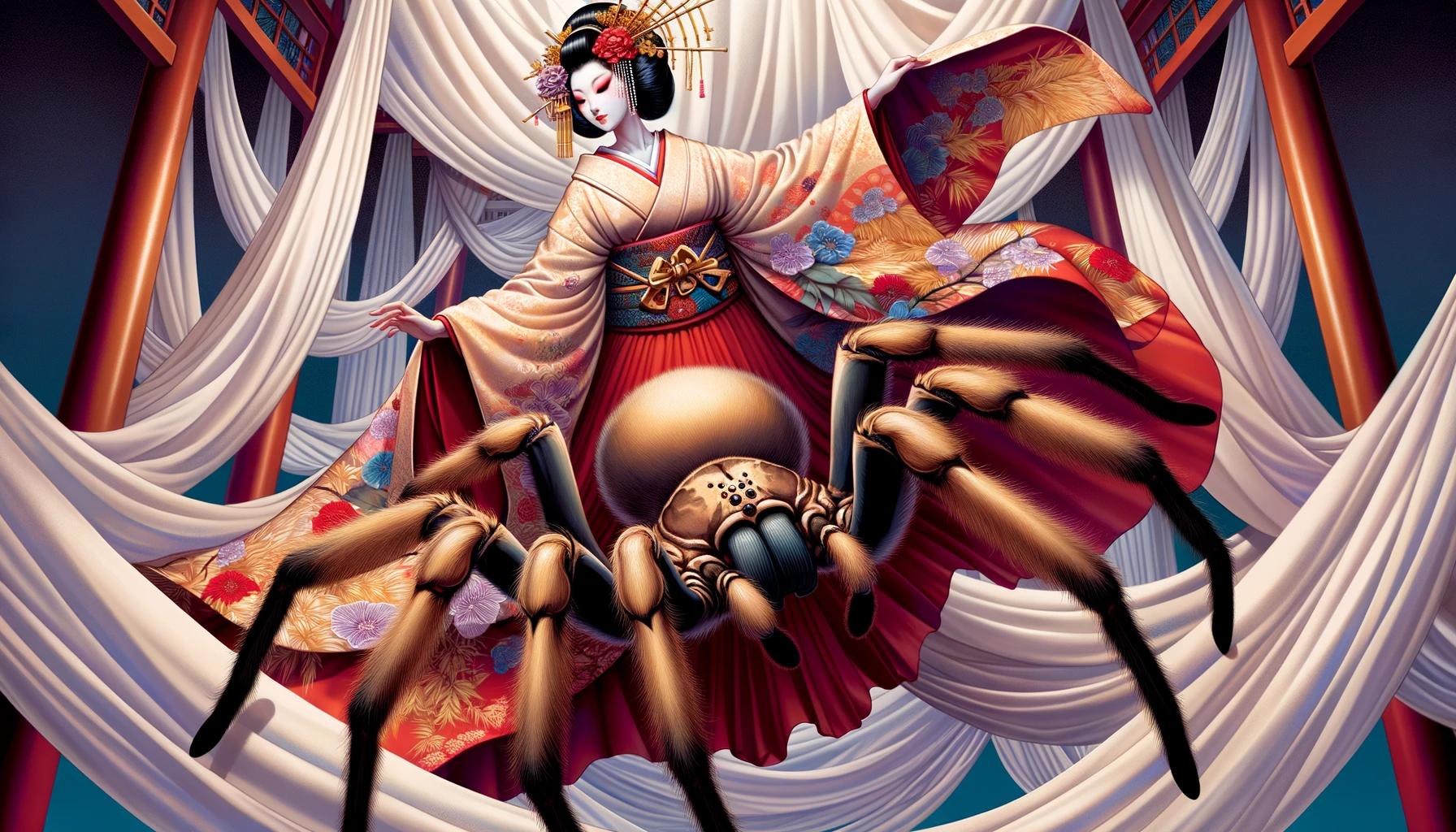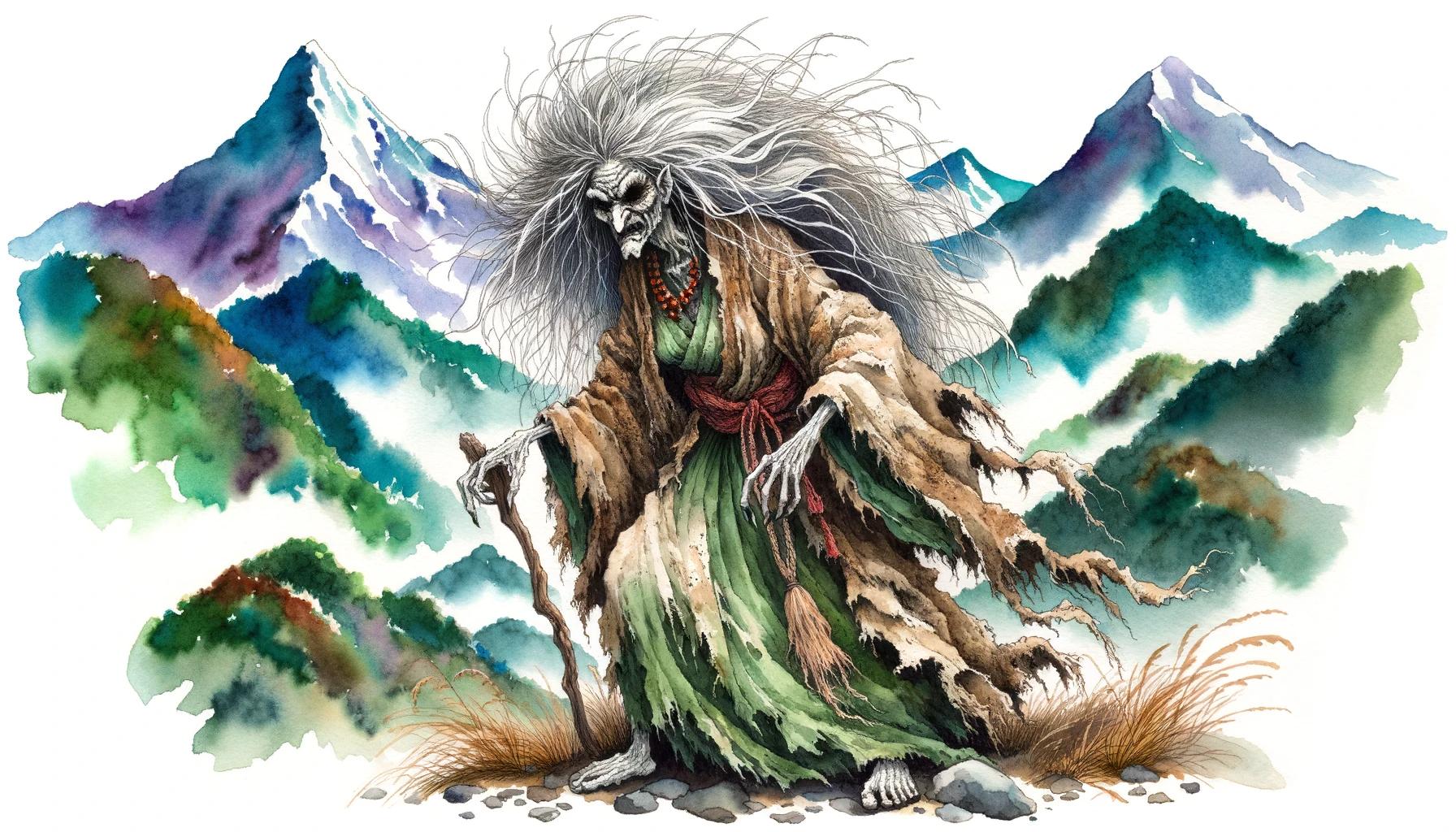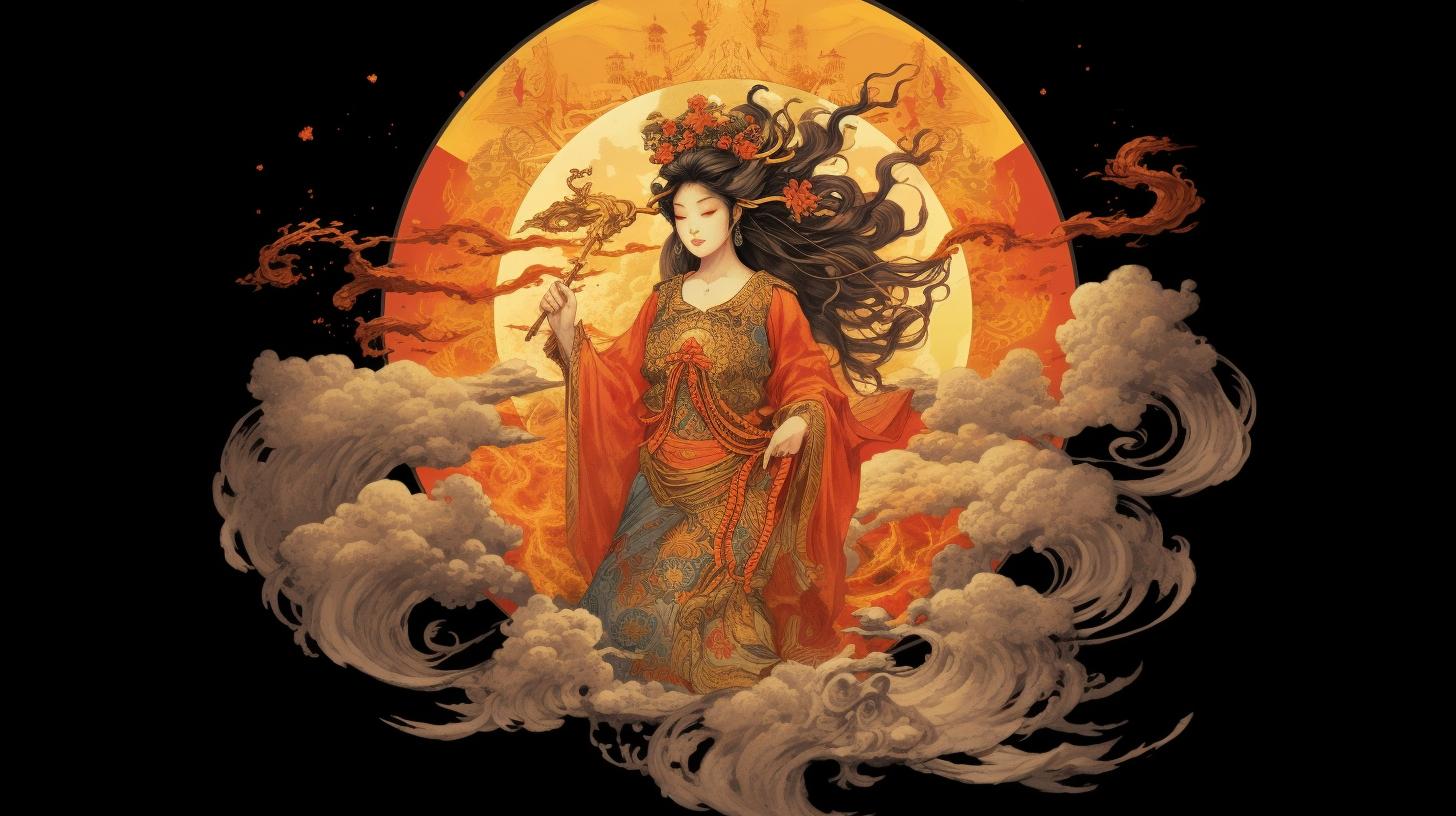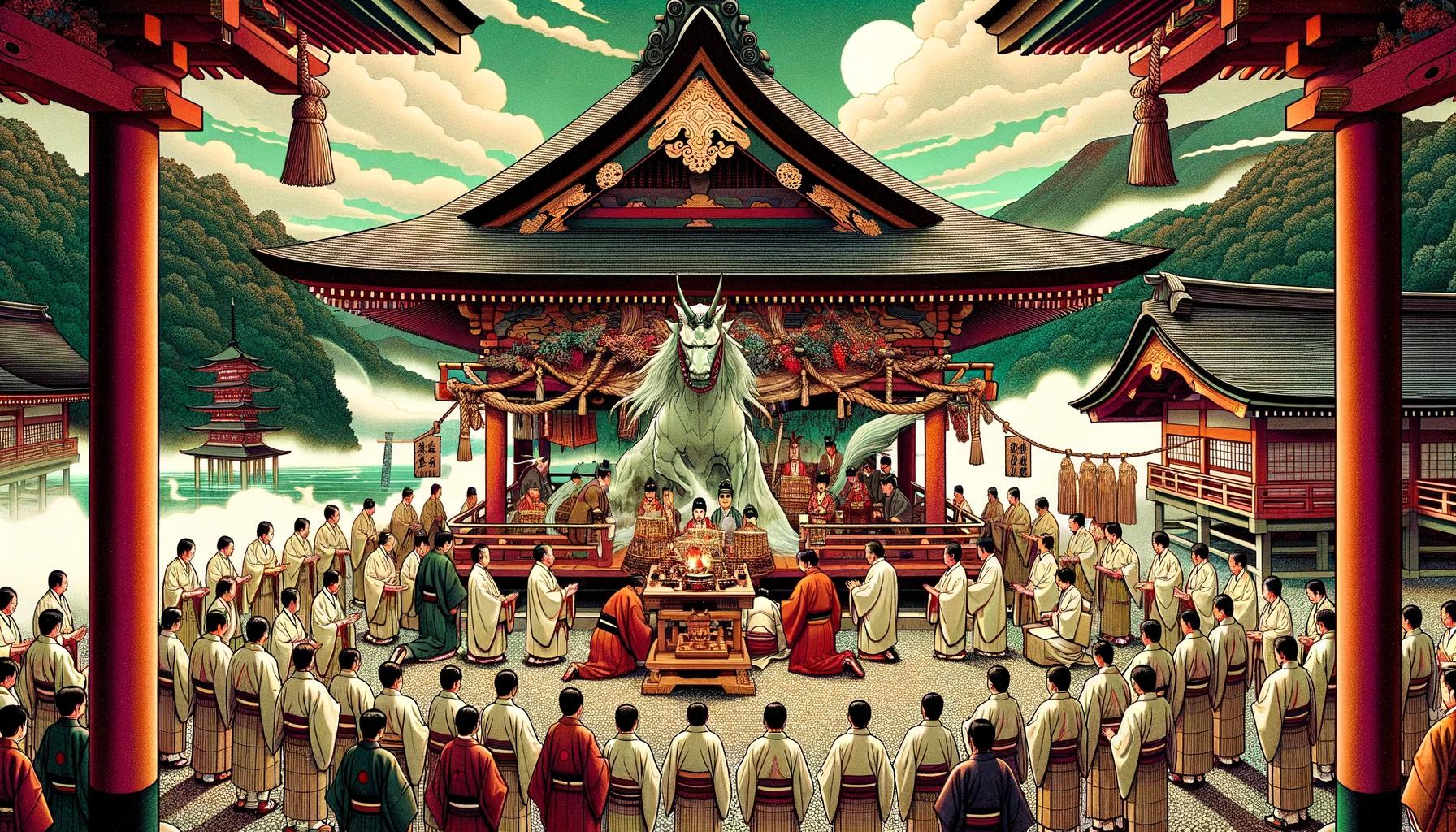Japanese Jorogumo Yokai: Mysterious Arachnid Creatures of Japan
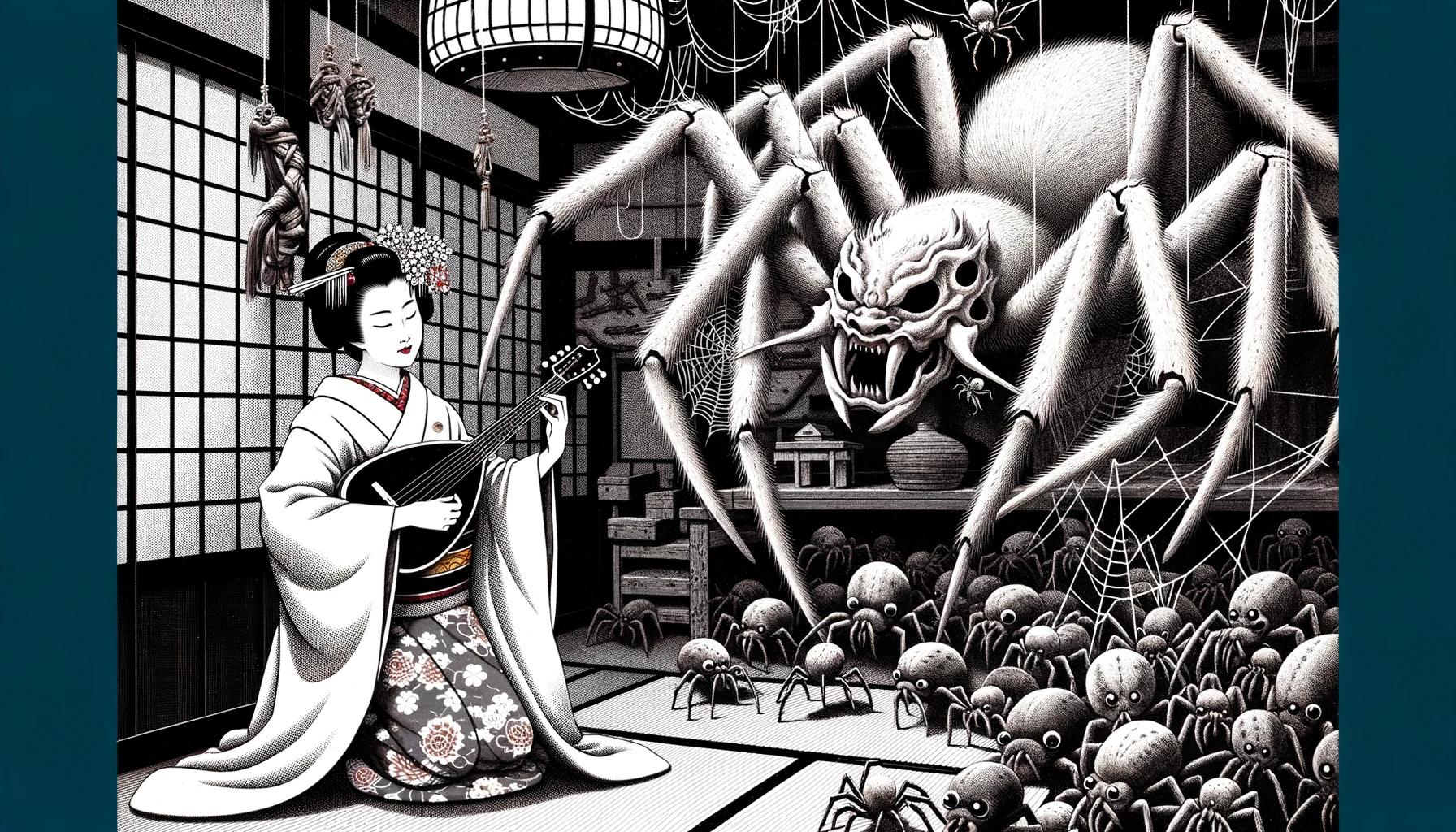
Japanese Jorogumo Yokai, also known as the Golden Orb Weaver, are supernatural spider-like creatures found throughout Japan, except in Hokkaido. These arachnids possess vibrant colors and build strong webs, but they are infamous for their cruelty and the destruction they bring upon young men’s lives.
With an average size of two to three centimeters, some Jorogumo can even capture and devour small birds. In Japanese folklore, Jorogumo is known as the ‘enchanting bride’ but originally referred to as the ‘prostitute spider,’ reflecting their deceptive nature and seductive abilities.
Overview of Japanese Yokai Creatures
The world of Japanese folklore is rich with fascinating and mythical creatures known as yokai. These supernatural beings have captured the imaginations of people for centuries, with their unique stories, appearances, and abilities.
Yokai are entities that exist outside the realm of ordinary human understanding, often associated with nature, spirits, and the supernatural.
Introduction to Yokai in Japanese Folklore
Yokai play a significant role in Japanese mythology and culture. They are creatures that inhabit a realm between the physical and spiritual world, often blending elements of human and animal attributes.
These beings can range from mischievous and playful to malevolent and dangerous. They are deeply rooted in Japanese folklore, appearing in various forms across literature, art, theater, and even contemporary media.
Classification of Yokai
Yokai can be classified into several different categories based on their characteristics and origins. Some common types include animal spirits (shapeshifting creatures with animal attributes), yuurei (ghosts of the deceased), obake (objects or animals that come to life), and oni (supernatural beings with demonic features).
Each category encompasses a wide array of unique entities, with their own stories and cultural significance.
Significance of Jorogumo Yokai
One notable yokai creature is the Jorogumo, also known as the Golden Orb Weaver or the Spider Woman. This arachnid yokai holds a special place in Japanese folklore and mythology.
Its significance lies in its seductive and deceptive nature, often luring unsuspecting victims into its web. The Jorogumo symbolizes the dangers of temptation and the consequences of falling into its trap.
Its tales serve as cautionary reminders for individuals to be wary of external allurements.
The Legend of Jorogumo
The legend of Jorogumo is deeply rooted in Japanese folklore and mythology. This captivating tale explores the origin and mythological background of the enigmatic creature, delves into its appearance and characteristics, unveils its supernatural powers and abilities, and highlights its presence in Japanese art and literature.
Origin and Mythological Background
According to ancient Japanese legends, Jorogumo was once an ordinary spider that lived a mundane life. However, after reaching a certain age and size, it gained the ability to transform itself into a seductive woman, often depicted as a beautiful enchantress.
This transformation was believed to be a result of accumulating spiritual energy over time.
Appearance and Characteristics of Jorogumo
Jorogumo is described as a spider-like yokai with a mesmerizing presence. Its physical appearance varies, yet it typically possesses a large, colorful body adorned with intricate patterns. With an average size of two to three centimeters, some Jorogumo specimens can grow much larger, enabling them to capture and consume small birds.
They are known for their vibrant colors and their skill in weaving large, sturdy webs that serve as both traps and shelters.
Supernatural Powers and Abilities
Jorogumo is renowned for its supernatural powers, which heighten its allure and mystique. It possesses the ability to manipulate its surroundings, such as controlling the threads of its web or affecting the emotions of those it encounters.
It is said to possess the power of illusion, able to enchant and deceive its victims with its seductive appearance and charm.
Jorogumo in Japanese Art and Literature
The captivating nature of Jorogumo has inspired numerous artists and writers throughout Japanese history. It has been depicted in various forms of art, including traditional paintings, woodblock prints, and sculptures. Its presence in literature is prominent as well, often portrayed as a cunning and treacherous entity that ensnares unsuspecting men.
Jorogumo’s Infamous Deeds
Seduction and Cruelty towards Young Men
Jorogumo, the seductive yokai spider, is infamous for her ability to enchant and ensnare young men. With her alluring appearance and mesmerizing charm, she lures unsuspecting victims into her web of deceit.
Once caught, she reveals her true nature, tormenting and devouring those who fall under her spell.
Stories of Jorogumo’s Victims
Throughout Japanese folklore, tales of Jorogumo’s victims abound. These stories serve as cautionary tales, warning young men to be wary of beautiful women they encounter. One such story tells of a man who became entranced by an enchanting woman.
Little did he know, she was actually a Jorogumo in disguise. As their relationship progressed, he began to notice her true arachnid form, leading to a terrifying encounter.
Another famous story revolves around a group of villagers who were plagued by Jorogumo’s cruel nature.
She would target young men, seducing them and trapping them in her web. It wasn’t until one brave villager discovered her true identity and devised a plan to defeat her that the village was finally freed from her malicious grasp.
Cultural Significance and Moral Lessons
Jorogumo’s actions symbolize the dangers of lust, deception, and the consequences of falling for superficial charms. These cautionary tales and legends surrounding Jorogumo serve as reminders to individuals to look beyond appearances and to exercise caution in their relationships and interactions.
The cultural significance of Jorogumo extends beyond mere folklore. The tales of her infamous deeds have permeated Japanese art, literature, and even theatrical performances. Her presence in various mediums serves as a constant reminder of the moral lessons associated with her actions.
Jorogumo’s Habitat and Distribution
Jorogumo, the fascinating Japanese yokai, can be found across the entire archipelago of Japan, with one notable exception: the island of Hokkaido.
Geographical Range of Jorogumo
Jorogumo yokai has managed to establish its presence in various regions of Japan, captivating the imaginations of the locals. From the southernmost tip in Kyushu to the western regions of Kansai, and stretching all the way to the eastern areas of Kanto and Tohoku, Jorogumo’s habitat covers a vast territory.
It thrives in the temperate climate of Japan, favoring humid and forested landscapes.
Preferred Environments and Nesting Habits
Jorogumo displays a preference for secluded and serene environments, often choosing to dwell in the tranquility of forests, mountainsides, or abandoned buildings. These locations provide not only ample hiding spots but also easy access to unsuspecting prey.
Jorogumo is known to skillfully spin giant, robust, and intricate webs that serve as both traps and shelters. These webs can be found draped between trees, in caves, or even in hidden corners of abandoned structures.
Hokkaido Exception: Absence of Jorogumo
Despite its pervasive presence throughout Japan, the Jorogumo yokai notably avoids the island of Hokkaido. Its absence in this region remains a mystery to yokai enthusiasts and researchers alike. While various theories have been proposed, including climate considerations or alternate indigenous creatures occupying the niche, the true reason behind Jorogumo’s absence from Hokkaido remains unsolved.
Interesting Facts and Folklore about Jorogumo
Discover intriguing facts and captivating folklore surrounding the enigmatic Jorogumo Yokai. This section sheds light on Jorogumo’s association with other Yokai, delves into fascinating legends and tales featuring Jorogumo, and explores rituals and beliefs used to ward off this mysterious creature.
Jorogumo’s Association with Other Yokai
In Japanese folklore, Jorogumo is often associated with various other Yokai, creating intricate connections within the supernatural realm. One notable association is with the Tsuchigumo, another spider-like Yokai known for its shape-shifting abilities.
Legends depict Jorogumo and Tsuchigumo engaging in epic battles or forming alliances in their pursuit of mischief and malevolence.
Jorogumo Legends and Tales
Throughout history, numerous legends and tales have emerged, depicting the cunning and treacherous nature of Jorogumo. Stories recount encounters with the seductive Yokai, who uses their enchanting powers to manipulate unsuspecting victims.
Folklore often presents Jorogumo as a cautionary tale, warning against falling prey to its alluring charms and exposing the consequences of crossing paths with this fearsome creature.
Rituals and Beliefs to Ward Off Jorogumo
Over time, several rituals and beliefs have developed to protect oneself from the influence or harm caused by Jorogumo.
These practices aim to repel the Yokai’s advances and ward off its ill intentions. Folk remedies include reciting chants, displaying protective charms, and even performing intricate dances believed to keep Jorogumo at bay.
By following these traditions, people seek to safeguard themselves from the web of danger woven by this ferocious creature.
Unlock the captivating world of Jorogumo Yokai as you delve into its intriguing associations, spellbinding legends, and protective rituals.
Explore the intricate web of Japanese folklore surrounding this seductive and dangerous creature, and gain a deeper understanding of the fascinating realm of Yokai.
FAQs about Jorogumo Yokai
Get answers to frequently asked questions about the enigmatic Jorogumo yokai.
What is the meaning of ‘Jorogumo’?
‘Jorogumo’ translates to ‘entangling bride’ in Japanese, but its original meaning is ‘prostitute spider.’ This name reflects the creature’s seductive nature and its ability to transform into a beautiful woman to lure its victims.
Can Jorogumo actually transform into a seductive woman?
According to Japanese folklore, Jorogumo possesses the supernatural power of shapeshifting. It can indeed assume the form of an alluring woman to tempt and ensnare unsuspecting individuals, often leading them to their demise.
Are Jorogumo spiders dangerous to humans?
Jorogumo spiders are not inherently dangerous to humans unless provoked or threatened. While their venomous bites can cause discomfort and localized reactions, severe cases of envenomation are rare. However, it is important to exercise caution and avoid disturbing these creatures if encountered in their natural habitat.
How can one protect themselves from Jorogumo?
- Avoid venturing alone into secluded areas known to be inhabited by Jorogumo yokai.
- Be cautious of encounters with suspiciously attractive women or individuals displaying arachnid-like characteristics.
- Carry protective amulets or talismans, such as ofuda or omamori, believed to ward off evil spirits and yokai.
- Stay informed about local legends and folklore, as increased knowledge can help identify and avoid potential encounters with Jorogumo.
By following these precautions, you can reduce the likelihood of falling prey to the allure and cruelty of the Jorogumo yokai.
.

